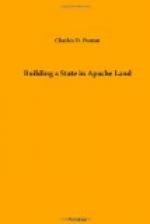A few straggling Americans came along now and then on pretense of seeking employment. When questioned on that delicate subject, they said they would work for $10 a day and board; that they got that in California, and would never work for less. After staying a few days at the company’s expense they would reluctantly move on, showing their gratitude for hospitality by spreading the rumor that “the managers at Tubac employed foreigners and greasers, and would not give a white man a chance.” They were generally worthless, dissipated, dangerous, low white trash.
Many Mexicans that had been formerly soldiers at the presidio of Tubac had little holdings of land in the valley, and returned to cultivate their farms, in many cases accompanied by their families.
By Christmas, 1856, an informal census showed the presence of fully a thousand souls (such as they were) in the valley of the Santa Cruz in the vicinity of Tubac. We had no law but love, and no occupation but labor. No government, no taxes, no public debt, no politics. It was a community in a perfect state of nature. As “syndic” under New Mexico, I opened a book of records, performed the marriage ceremony, baptized children, and granted divorces.
Sonora has always been famous for the beauty and gracefulness of its senoritas. The civil wars in Mexico, and the exodus of the male population from Northern Mexico to California, had disturbed the equilibrium of population, till in some pueblos the disproportion was as great as a dozen females to one male; and in the genial climate of Sonora this anomalous condition of society was unendurable. Consequently the senoritas and grass widows sought the American camp on the Santa Cruz River. When they could get transportation in wagons hauling provisions they came in state,—others came on the hurricane deck of burros, and many came on foot. All were provided for.
The Mexican senoritas really had a refining influence on the frontier population. Many of them had been educated at convents, and all of them were good Catholics. They called the American men “Los God-dammes,” and the American women “Las Camisas-Colorados.” If there is anything that a Mexican woman despises it is a red petticoat. They are exceedingly dainty in their underclothing,—wear the finest linen they can afford; and spend half their lives over the washing machine. The men of northern Mexico are far inferior to the women in every respect.
This accretion of female population added very much to the charms of frontier society. The Mexican women were not by any means useless appendages in camp. They could keep house, cook some dainty dishes, wash clothes, sew, dance, and sing,—moreover, they were expert at cards, and divested many a miner of his week’s wages over a game of monte.
As Alcalde of Tubac under the government of New Mexico, I was legally authorized to celebrate the rites of matrimony, baptize children, grant divorces, execute criminals, declare war, and perform all the functions of the ancient El Cadi. The records of this primitive period are on file in the Recorder’s office of the Pueblo of Tucson, Pima County.




